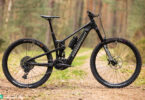The unique look of ebike pioneer Haibike is easy to recognise on the trail, and the design of the Haibike XDURO AllMtn 3.0 is no exception. Can its performance on the trail do the aggressive look justice?
For an overview about the test field click here: The best budget eMTB of 2019 – 8 models head to head
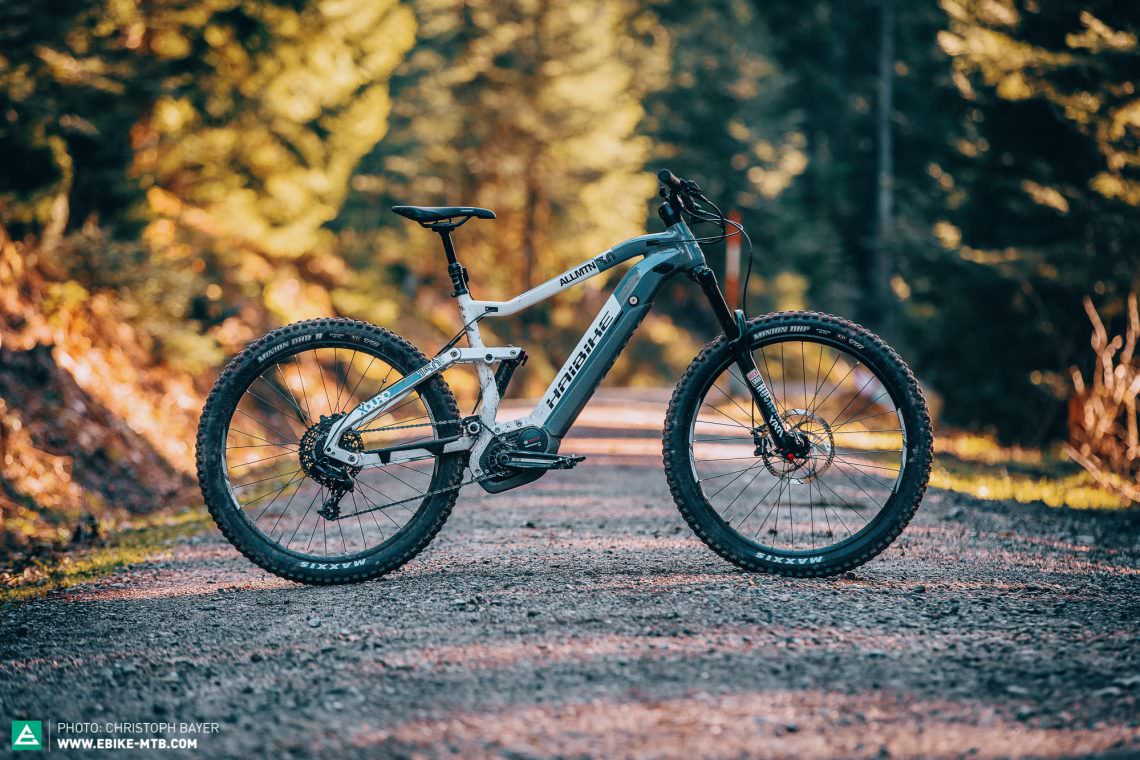
While the flagship FLYON XDURO AllMtn range features carbon frames and TQ motors, the more affordable XDURO AllMtn models are based on last year’s aluminium frame. Our € 4,399 Haibike XDURO AllMtn 3.0 test bike comes with the proven Bosch Performance Line CX motor and an integrated battery. The paintwork and finishing quality of the frame is clearly superior to most bikes in the test field and it even has space for a bottle cage in the front triangle. The in-house components such as the stem, handlebar and cranks suit the bike perfectly and leave a high-quality impression. However, the loud rattling of the jockey wheel on the rear linkage, the cable routing and the poorly chosen componentry mars this impression. With the SRAM NX 11-speed drivetrain, the German brand opted against the one-by specific shifter, with which – you guessed it – you can only shift one gear at a time. However, our main criticism of the build spec is the TRP G-Spec Trail S four-piston brake, which doesn’t provide enough braking power. The 160/150 mm travel RockShox suspension generates plenty of traction with the wide 27.5+ MAXXIS Minion tires and offers a lot of comfort.
A feast for the eyes! The quality and finish of the Haibike are unrivalled in this test field.
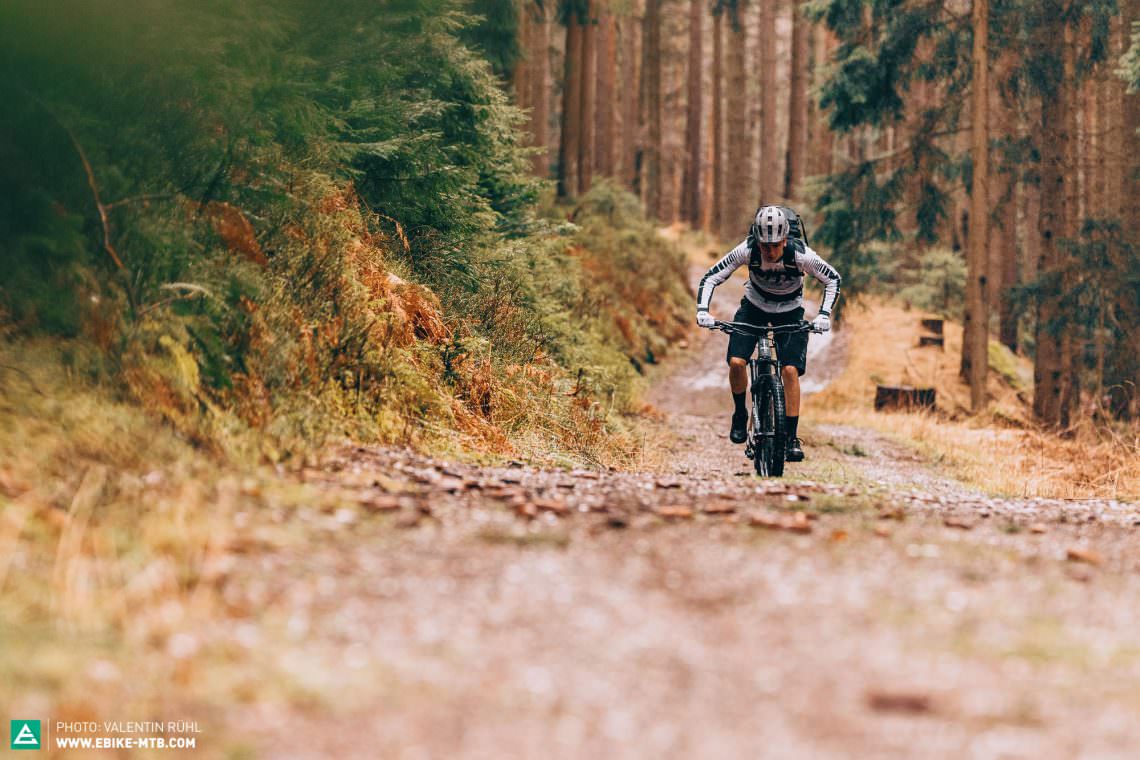
The Haibike XDURO AllMtn 3.0 in detail
Fork RockShox Yari RC 160 mm
Rear shock RockShox Deluxe RT 160 mm
Motor/Batterie Bosch Performance Line CX 500 Wh
Drivetrain SRAM NX
Brakes TRP G-Spec Trail S 200/180 mm
Seat post XLC AllMtn 125 mm
Stem Haibike Components TheStem 45 mm
Handlebar Haibike Components TheBar ++ 780 mm
Wheels RODI Tryp 35/Haibike Components TheHub ++ 27.5″
Tires MAXXIS Minion DHF/DHRII 2.8″
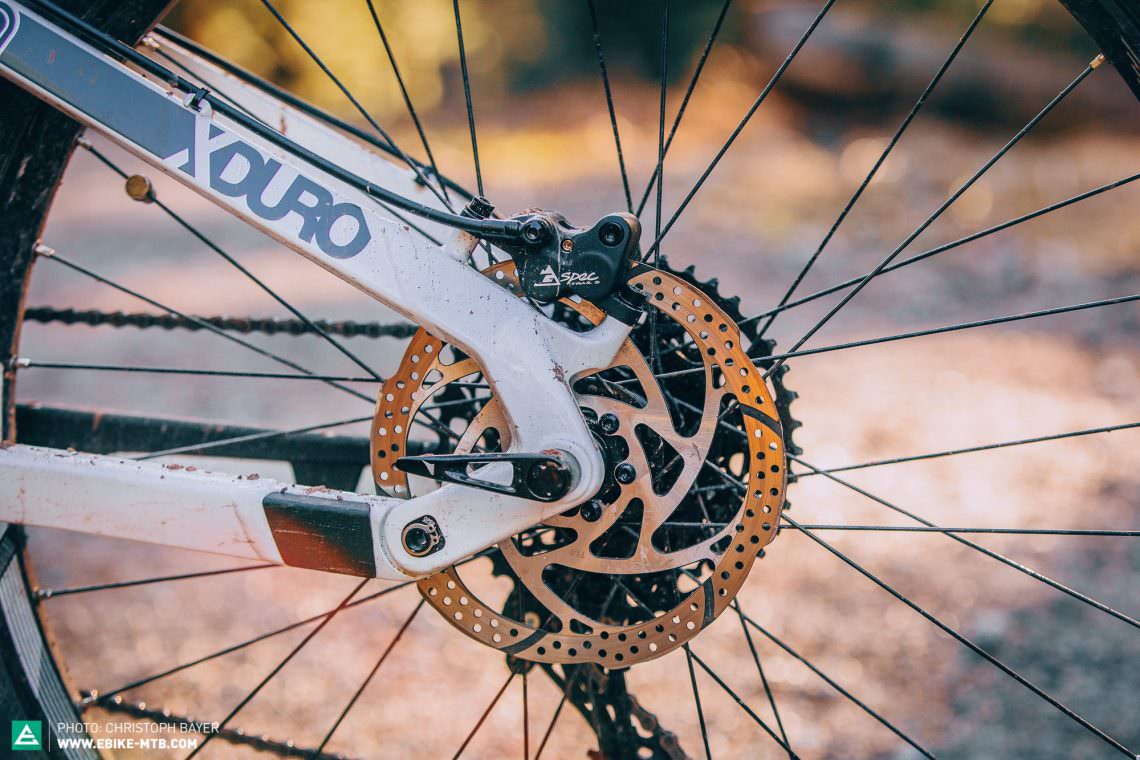
The TRP G-Spec Trail S with the “small” 180 mm brake rotor has far too little bite for the Haibike.
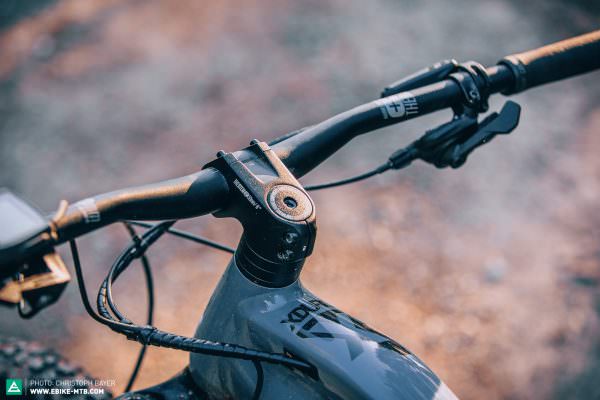
The in-house Haibike components such as the handlebar, stem and cranks suit the high-quality appearance of the XDURO AllMtn quite nicely.
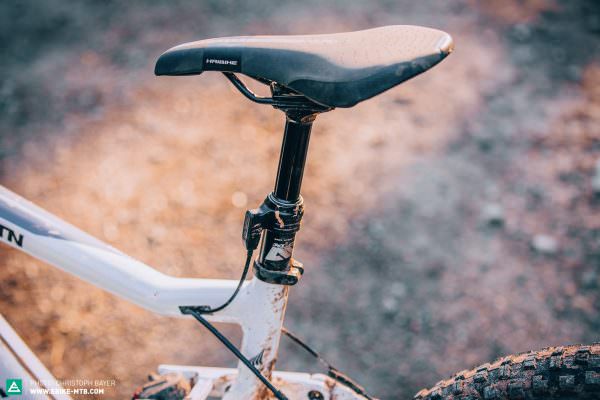
External cable routing and too little drop: with the exception of the lever, we weren’t convinced of the dropper post.

The ergonomics and function of the dropper remote are excellent. It doesn’t interfere with the Bosch Purion display either.

No matter what gear you’re in, the chain rattles loudly on the jockey wheel of the rear linkage.
| Size | S | M | L | XL |
|---|---|---|---|---|
| Seat tube | 410 mm | 440 mm | 470 mm | 500 mm |
| Top tube | 575 mm | 600 mm | 625 mm | 650 mm |
| Head tube | 115 mm | 120 mm | 125 mm | 130 mm |
| Head angle | 66° | 66° | 66° | 66° |
| Seat angle | 74° | 74° | 74° | 74° |
| Chainstay | 465 mm | 465 mm | 465 mm | 465 mm |
| BB Drop | -25 mm | -25 mm | -25 mm | -25 mm |
| Wheelbase | 1,195 mm | 1,221 mm | 1,246 mm | 1,272 mm |
| Reach | 409 mm | 433 mm | 457 mm | 481 mm |
| Stack | 621 mm | 625 mm | 630 mm | 635 mm |
The Haibike XDURO AllMtn 3.0 in review
The high drawn top tube and the tall front end of the Haibike XDURO AllMtn 3.0 give it a motocross feel. The seated riding position is very comfortable for long rides, as long as the climbs aren’t too steep or technical. On steep climbs, the XDURO AllMtn 3.0 with its 11-42T cassette lacks an easier gear. This is not necessarily due to lack of motor power, but rather to the incorrectly selected gear ratio with a 16-tooth chainring as well as the Haibike’s inefficient suspension. The shock tends to sag excessively and makes the already long and sluggish bike more difficult to climb. In combination with the 170 mm cranks, you have to be careful in picking your lines over obstacles to avoid hitting the pedals or the motor.
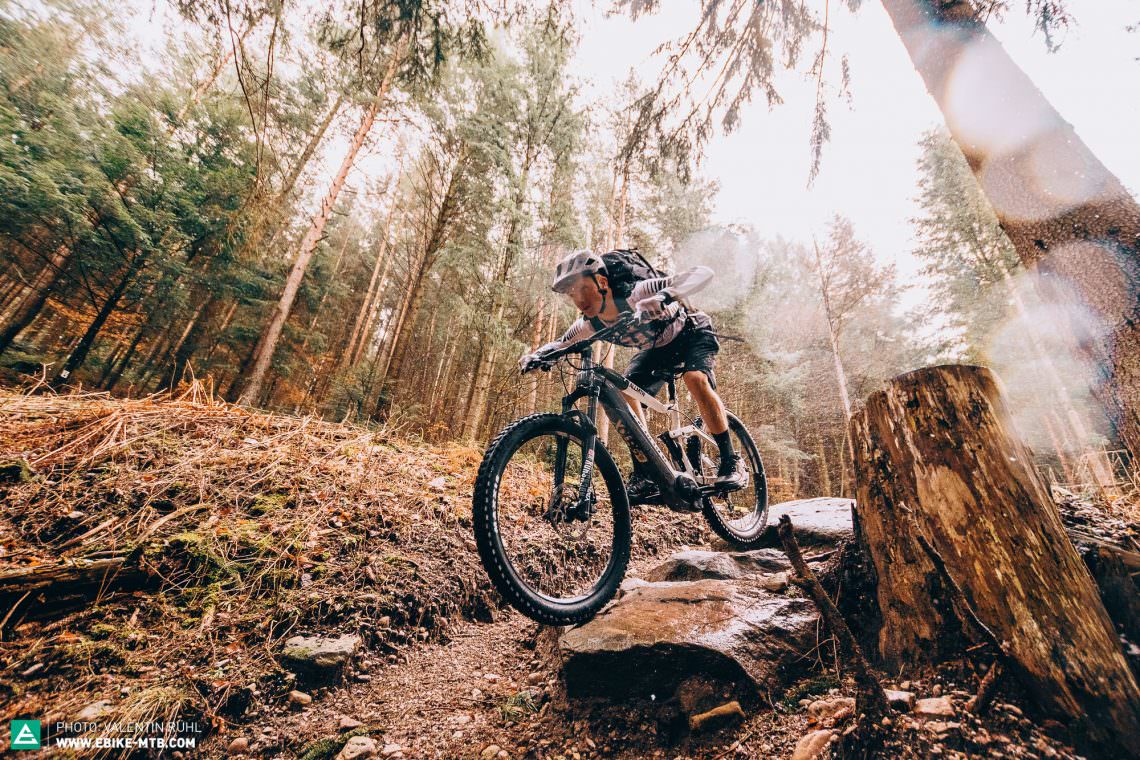
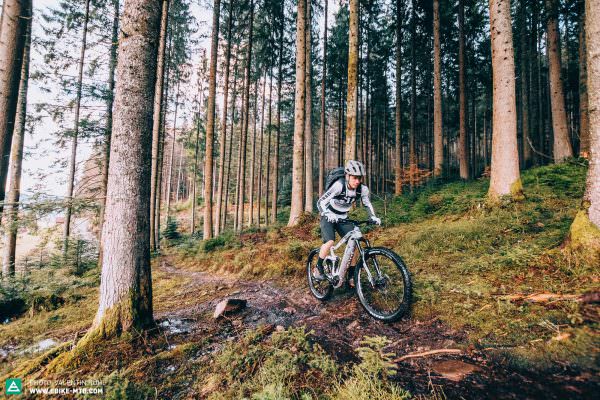

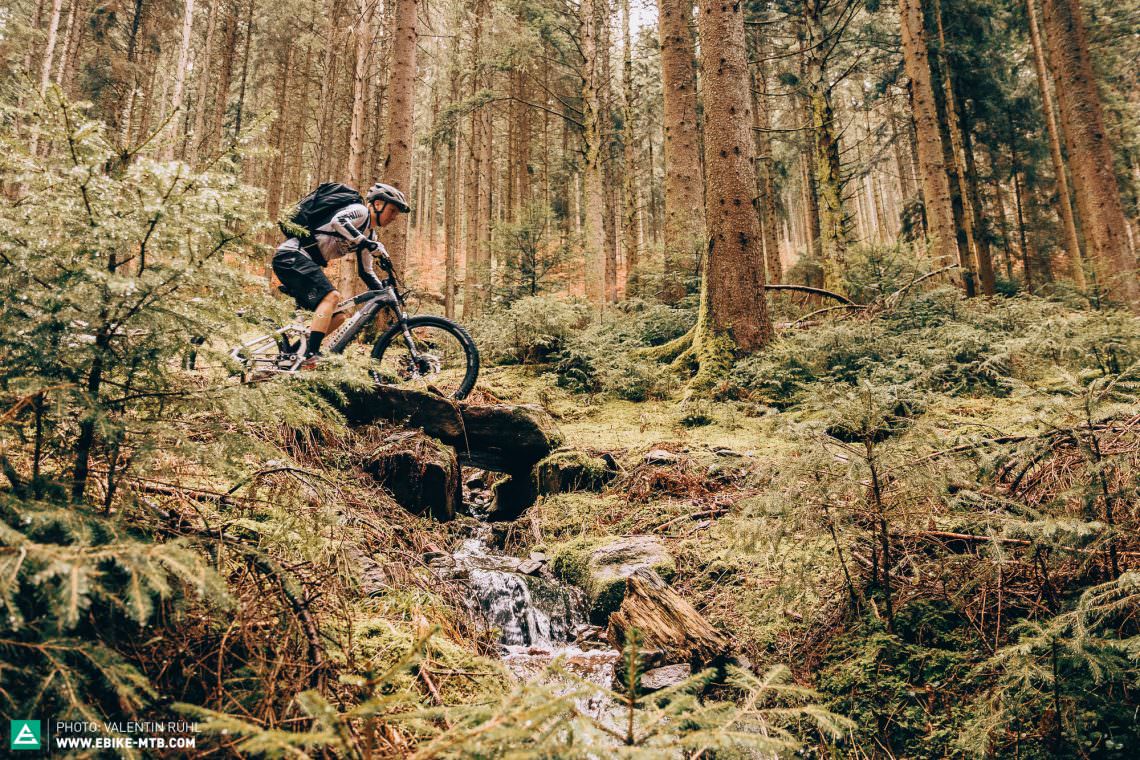
Going downhill, the Haibike initially feels very composed. The tall front end, coupled with the low bottom bracket, places the rider very centrally and low on the bike. Feeling like you’re going over the bars? No chance. Freedom of movement? None either, unfortunately. You constantly bump your knees into the offset top tube and you can’t drop the saddle enough because of the short travel dropper post, further limiting your movement. This makes the XDURO AllMtn 3.0 difficult to lean into corners or roll over ledges. Agility is not the Haibike’s strong suit, but it scores with its composure: the suspension and the 2.8″ wide MAXXIS tires iron over bumps like you’re riding a trail of clouds. It takes a lot of physical effort to get the bike into the air or around a corner – and to slow it down, unfortunately. The TRP G-Spec Trail S brakes are overwhelmed by the weight of the Haibike and require a lot of finger power to bring the bike to a halt.
Rubber prison cell: the Haibike XDURO AllMtn 3.0 completely isolates the rider from the trail.
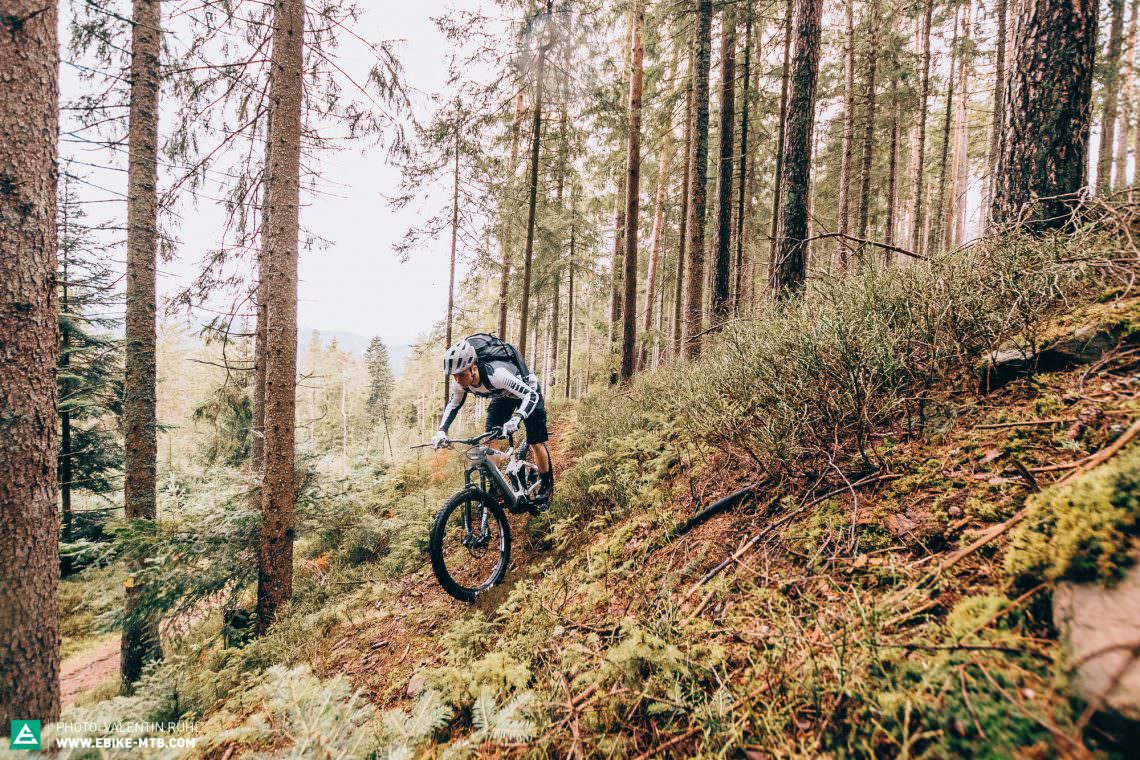
Conclusion
The comfort of the Haibike XDURO AllMtn 3.0 is best for long rides. It remains very composed on the trail at slow speeds but requires so much physical effort for agile riding manoeuvres that we can’t recommend it to ambitious trail rider. Be sure to replace the brakes!
Tops
- looks
- Modular Rail System – bottle cage
- very composed
Flops
- underpowered brakes
- no feedback from the suspension
- low bottom bracket, paired with long cranks
- high standover height
- limited gear range
Riding Characteristics
4Agility
- sluggish
- playful
Stability
- nervous
- stable
Handling
- demanding
- balanced
Riding fun
- boring
- lively
Motor feeling
- digital
- natural
Motor power
- weak
- strong
Value for money
- poor
- top
For more information head to haibike.com
The Test field
For an overview about the test field click here: The best budget eMTB of 2019 – 8 models head to head
All bikes in test: Canyon Spectral:ON 7.0 | COMMENCAL META POWER 27 RIDE | CONWAY eWME 629 | FLYER Uproc7 4.10 | MERIDA eONE-SIXTY 800 | RADON SWOOP HYBRID 9.0 | Specialized Turbo Kenevo Comp
"The mountain hut is the destination, not the trails" – rides mainly on gravel paths and flowy singletrack, comfort plays a crucial role.↩
The focus is on riding fun. Riding skills: from beginner to experienced – the range extends from flowy singletracks to demanding technical trails.↩
A rider with very good bike control – rides on demanding and challenging technical trails, uphill as well as downhill.↩
The rating used for riding characteristics refers to the bikes in the group test and the current state of development of eMTBs. The best bikes managed to blend supposedly opposite riding characteristics, feeling both lively and stable at the same time. The handling describes the balance of the bike on downhill sections. The information regarding motor-power refers to the ride-feeling in the overall context of the bike and not exclusively to the motor – that’s why the same motor can present different values.↩
Did you enjoy this article? If so, we would be stoked if you decide to support us with a monthly contribution. By becoming a supporter of E-MOUNTAINBIKE, you will help secure a sustainable future for high-quality cycling journalism. Click here to learn more.
Words: Photos: Christoph Bayer, Valentin Rühl







